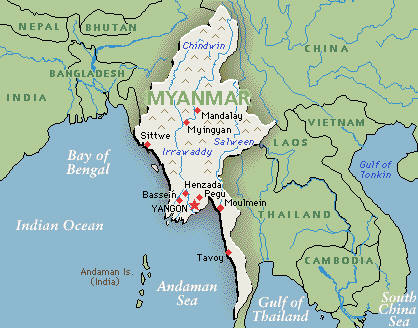Myanmar fascinates with its play of light and shadow
 Yangon - Gazing down upon the visitors to the temple complex at Bagan in Myanmar, formerly Burma, is a very mysterious Buddha figure. The 10-metre-high statue in the southern niche of Ananda temple smiles benevolently on everyone who approaches, but as you approach the statue its facial expression changes with every step.
Yangon - Gazing down upon the visitors to the temple complex at Bagan in Myanmar, formerly Burma, is a very mysterious Buddha figure. The 10-metre-high statue in the southern niche of Ananda temple smiles benevolently on everyone who approaches, but as you approach the statue its facial expression changes with every step.
When you stand just in front of the Buddha and look up you see a very serious face. The change is due to a play of shadow and light but the optical illusion could be emblematic of the entire country.
Standing in Myanmar's lighter side are its history and culture that stretch back more than a millennia while in the shadow stands its military dictatorship which has ruled the country since 1962.
Its temples and pagodas stand in stark contrast to the regime's torture prisons, its mostly unobtrusive people to the army who force children to take up weapons and suppress minorities.
Is it right to travel to such a country? It is true that some hotels and airlines are in the hands of the regime's henchmen, but people like taxi drivers, travel guides, gardeners, and chambermaids survive on income from tourists.
Contact with guests is also one of the few gateways to the outside world that people have, says one guide.
Anyone who makes the long journey from Bangkok or Singapore to the port city of Yangon enters another world. The country is steeped in Buddhism as can be seen from the countless small and large Buddha statues the lie or stand around the country or from the magnificent buildings such as the Shwedagon Pagoda in Rangoon. Its 100-metre-high Stupa is the city's emblem.
Visitors to the pagoda can be seen in prayer or engaged in ritual washing while all around a special atmosphere is created by the light chimes of a thousand small bells and the deep tone of gongs.
"Anyone who strikes a bell three times does so for Buddha, his teachings and his followers. If you strike a bell five times you include your parents and teacher," explains a guide.
The people of Myanmar easily and quickly switch between prayer and their everyday lives. One example was a young man wearing a white shirt and serious expression who extorted a dollar from a tourist who wanted to strike a bell. By chance he happened to be standing in the right place as the tourist looked for help. Yet anyone may strike a bell and there are no temple officials asking for money.
Yangon's market in Chinatown is a festival both for the eyes and nose because of its colours and aromas. Fish are presented to customers on tablets, meat on wooden stands. From the early hours of the day the market's streets are bustling with women balancing their purchases on their heads.
Yangon's Kandawgyi Lake is popular for jogging, strolling and playing games. Teenagers can also be found here performing break-dance shows.
A few streets away newspaper delivery people are preparing for their working day. The newspaper titles have promising names such as "Flower News" but the most exciting stories these state-controlled publications can produce are along the lines of "New Bridge Opened in Province XY."
Mandalay is about 700 kilometres north of Yangon. The city is home to the Mahmuni Pagoda, Myanmar's most important pilgrimage site next to the Shwedagon Pagoda.
The Mahmuni Buddha is four-metres-high but beneath its chin it has been deformed into a shapeless clump of gold thanks to the gold leaves placed there by pilgrims over the last 150 years.
Mandalay is Myanmar's traditional place of learning. In 1993 abbot U Nayaka founded the monastic school Phanung Daw Oo which today has 700 students.
The words "Children can come to happily learn here without having to pay" are inscribed on a sign at the school. The school receives support from western donors and visitors are welcome to call by.
Located on the school grounds is a large kitchen, a workshop for training, and lodgings for both boys and girls.
Bagan is what could be described as a Buddha paradise thanks to its 2,700 pagodas. It is a stunning site on a par with Cambodia's temple complex at Angkor Wat.
Until the mid-1990s people lived in huts between the temples. The military authorities drove them away "in order to protect the structures." Today, some of the country's best hotels can be found in prime positions along the Irrawaddy river. Some of them even have pagodas on their grounds.
The most contemplative way to explore Bagan is to travel between cotton fields and sand paths with a horse drawn carriage.
Each pagoda has its own unique story. The largest is the Dhammayangyi Temple which was built in 1167 by King Narathu. According to legend Narathu was a strict ruler. If he could place a needle between blocks in the temple's wall that meant death for the mason.
Another highlight on a trip to Bagan is Ananda Temple, built in 1105, with its sometimes friendly, sometimes serious looking Buddha. If you leave the temple by its southern gate and cast a glance over your shoulder you will see the kindly face. (dpa)